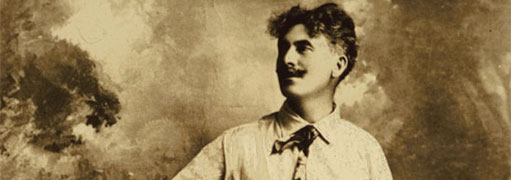Ernest Thompson Seton spent his life making people aware of their impact on nature and introducing youth to the outdoors. He was an artist, woodsman and mentor who wrote more than 50 books. He confounded the worldwide Boy Scouts movement. And he was once an avid hunter who was changed into a conservationist by a spiritual experience he had in New Mexico. The Academy for the Love of Learning, based outside Santa Fe, is about to open its permanent Seton Gallery. The nonprofit’s mission is to nurture wonder, curiosity and critical thought through multiple projects and workshops. David Witt, the curator of the new collection and author of a Seton biography, says Seton developed what he called the “Lifecraft philosophy.” It had to do with coming to terms with one’s place in society and nature. “Once we decide who we are as individuals,” Witt says, “then it works outward from that into, What can I do for the larger community?” He says this way of thinking is similar to the pedagogy developed by Aaron Stern, the founder of the academy. In the work of the academy, Witt says, there’s a lot of emphasis on personal transformation. Seton is an example of someone who underwent such a major change. He’s a perfect mascot for the organization. Since Aug. 14 marks his 151 st birthday, it’s a fitting time to unveil the gallery. Seton was born in Scotland in 1860, and immigrated with his family to Toronto when he was 6 years old. He grew up taking long walks in the woods, studying and sketching animals. His drawing skills developed, and he did a brief stint at the Royal Academy of Arts in London. When he returned to Canada, he continued to camp, hike and sketch wildlife. He felt a close connection to the ways of the First Nations people. He was also a hunter, says Melissa Stevens, community development manager at the academy. Sometimes he hunted to procure the anatomy of an animal he wanted to draw; other times it was for money.By 1883, when he made his first visit to the United States, Seton was an established wildlife artist. It was October, and he had come to New Mexico to hunt wolves. As the story goes, he was tracking a mated pair and shot the female. Throughout the night he heard the howling of the male, whom he named Lobo, and was deeply affected. In the morning Seton found Lobo caught in a trap he had set, looked into its eyes and decided he couldn’t shoot him. Stevens says Seton never killed again.“He got on a path where he came to believe that animals, including wild animals, are different from humans not in any fundamental way, but only by degree,” Witt says. “In the 1890s this was extremely radical.” Native Americans and First Nations people already believed this. Seton had studied some of their cultures and spent a lot of time with First Nations people in Canada, so he was already familiar with the concept, but Witt says Seton didn’t understand it until he had the encounter with the wolves in New Mexico. Seton became one of the primary advocates in the early wildlife conservation movement, and he formed the principles that developed into the Boy Scouts. “He thought it was necessary that he take what he had learned and share it with a wider audience,” Witt says. It’s estimated that since its inception, more than 350 million young people have been involved in scouts programs.Seton spent his last years in a castle he built near Santa Fe, and the Academy for the Love of Learning is on this land. The castle burned down after the academy acquired it, but not before most of the contents had been removed. It’s through these rescued archives, on display in the new gallery, that visitors can chart their own course through Seton’s life. The walls are covered with paintings, Witt says. Slide open more than 50 storage drawers to see other paintings and sketches of mammals, birds, people and canoes. His journals, manuscripts and other personal items are included in the trove. There are even some pieces of his furniture. Continuing its theme of transformation, the Academy for the Love of Learning has rebuilt the ruins of the castle into a meditation garden. Visitors can listen to the birds and feel the sun, then head inside to connect with a fascinating man who loved nature, too.
Seton Gallery Grand Opening
Sunday, Aug. 14, 1 to 4 p.m.
Academy for the Love of Learning
133 Seton Village Road, Santa Fe
Tickets: Free, donations appreciated
(505) 995-1860,
aloveoflearning.org










